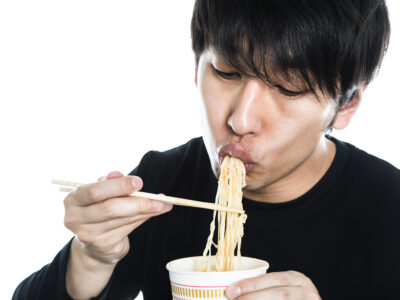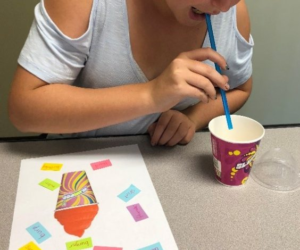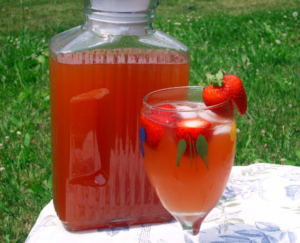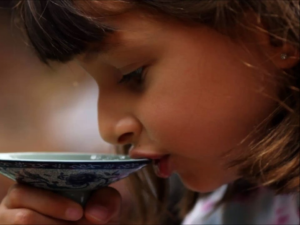You’ve likely encountered it while enjoying a bowl of hot soup or a refreshing beverage, and you may have even engaged in it yourself, knowingly or otherwise. It’s a sound that has sparked debates on manners, etiquette, and cultural differences. What, you might ask, is this enigmatic sound that we’re about to explore in detail? Prepare to delve into the world of the “slurp sound.“
The slurp sound is a common one in the natural world. It is the sound of drinking, of eating, of sucking. It is a sound that is both satisfying and disgusting, depending on the context. On a hot summer day, the sound of someone slurping a cold glass of lemonade is a welcome one.
Moreover, it is a sound that evokes images of relaxation and refreshment. But the sound of someone slurping their soup loudly and messily can be quite off-putting. The slurp sound is also a common sound in the animal kingdom. Dogs slurp up their water bowls, cats slurp up their milk, and elephants slurp up water with their trunks. Even insects slurp up nectar from flowers.
The slurp sound is made when a liquid or gas is drawn into a mouth or other opening. The tongue helps to create a vacuum, which sucks the liquid or gas in. The lips then close to create a seal, preventing the liquid or gas from escaping.
What is the slurp sound?
The slurp sound is a noise that is made when someone drinks or eats noisily, especially liquids. It is caused by the suction of air and liquid into the mouth. The slurp sound can be loud or soft, depending on the person and how quickly they are drinking or eating.
Slurping is often considered to be rude in many cultures, but it is not always. For example, in some cultures, slurping soup is seen as a sign of enjoyment. In other cultures, slurping noodles is seen as a way to cool them down before eating them.
Here are some examples of situations where you might hear a slurp sound:
- A person slurping soup with a spoon
- A child slurping a milkshake
- A dog slurping water from a bowl
- A cat slurping milk from a saucer
- A person slurping noodles
The slurp sound can also be used to describe other types of noises, such as the sound of waves crashing on a shore or the sound of a vacuum cleaner sucking up dirt.
How do people create slurp sounds when drinking?
People create slurp sounds when drinking by sucking air and liquid into their mouths at the same time. This creates a vacuum in the mouth, which causes the liquid to rush in. The sound is created by the air and liquid hitting the back of the throat and tongue.
There are a few different ways that people can create slurp sounds when drinking:
- Using a straw: When someone drinks through a straw, they create a vacuum by sucking on the straw. This causes the liquid to rush up the straw and into the mouth. The slurp sound is created by the air and liquid hitting the back of the throat and tongue.
- Without a straw: When someone drinks without a straw, they can create a slurp sound by sucking on the liquid directly from the cup. This also creates a vacuum in the mouth, which causes the liquid to rush in. The slurp sound is created by the air and liquid hitting the back of the throat and tongue.
- With a spoon: When someone drinks soup with a spoon, they can create a slurp sound by dipping the spoon into the soup and then quickly bringing it to their mouth. This creates a vacuum in the mouth, which causes the soup to rush in. The slurp sound is created by the air and soup hitting the back of the throat and tongue.
The loudness of the slurp sound depends on a few factors, such as the size of the person’s mouth, the amount of liquid being ingested, and the speed at which the person is drinking.
Some people slurp their drinks without even realizing it. Others may do it intentionally, for example, to cool down a hot drink or to savor the taste of the drink.
Are slurp sounds considered polite or impolite?
Slurping sounds are generally considered to be impolite in many cultures. This is because they can be seen as rude, unrefined, or even disgusting. Slurping can also be disruptive and annoying to others, especially in quiet settings.
However, there are some cultures where slurping is considered to be polite or acceptable. For example, in some Asian cultures, slurping soup is seen as a sign of enjoyment and appreciation. In other cultures, slurping noodles is seen as a way to cool them down before eating them.
It is important to be aware of the cultural norms when you are in a new place. If you are unsure whether or not it is polite to slurp, it is best to err on the side of caution and avoid doing it.
Can slurping be cultural and vary by region?
Slurping sounds are generally considered to be impolite in many cultures. This is because they can be seen as rude, unrefined, or even disgusting. Slurping can also be disruptive and annoying to others, especially in quiet settings.
However, there are some cultures where slurping is considered to be polite or acceptable. For example, in some Asian cultures, slurping soup is seen as a sign of enjoyment and appreciation. In other cultures, slurping noodles is seen as a way to cool them down before eating them.
It is important to be aware of the cultural norms when you are in a new place. If you are unsure whether or not it is polite to slurp, it is best to err on the side of caution and avoid doing it.
slurping can be cultural and vary by region.
In some cultures, slurping is considered to be rude and impolite. For example, in Western cultures, slurping soup is generally considered to be rude. In other cultures, slurping is considered to be acceptable or even polite. For example, in some Asian cultures, slurping soup is seen as a sign of enjoyment and appreciation.
Here are some examples of where slurping is considered to be polite or acceptable:
- In Japan, slurping noodles is a sign of appreciation for the food.
- In China, slurping soup is a sign of enjoyment.
- In Korea, slurping soup is seen as a way to cool it down before eating it.
- In Vietnam, slurping pho is a way to show that you are enjoying the soup.
It is important to be aware of the cultural norms when you are in a new place. If you are unsure whether or not it is polite to slurp, it is best to err on the side of caution and avoid doing it.
Are there health benefits to slurping hot beverages?
Slurping hot beverages like tea or soup is more of a cultural or personal preference than a recognized health practice. While there are some potential benefits associated with consuming hot beverages in general, these benefits are not specifically tied to the act of slurping. Here are a few potential advantages of consuming hot beverages:
- Soothing and Comforting: Hot beverages like tea, broth-based soups, or hot water can have a soothing and comforting effect. They are often used as remedies for relieving stress and promoting relaxation.
- Hydration: Drinking hot water or hot herbal teas can contribute to your daily fluid intake, helping to keep you hydrated. Proper hydration is important for overall health.
- Digestive Aid: Some people believe that consuming warm or hot liquids can aid digestion by helping to break down food more effectively. Warm liquids may also soothe an upset stomach.
- Nasal Congestion Relief: Inhaling steam from hot beverages can provide temporary relief from nasal congestion and throat discomfort when you have a cold or respiratory congestion.
- Antioxidants and Nutrients: Many hot beverages, such as herbal teas, contain antioxidants and various beneficial compounds that can support overall health.
- Caffeine Content: Hot beverages like coffee and certain types of tea contain caffeine, which can provide a mild energy boost and increase alertness.
It’s important to note that while hot beverages can offer these potential benefits, excessive heat can also pose risks, such as burning your mouth or throat. Therefore, it’s essential to consume hot beverages at a temperature that is comfortable for you and allows you to enjoy the beverage without causing harm.
Additionally, individual preferences vary, and not everyone enjoys the sensation of slurping hot beverages. Social etiquette also plays a role in how we consume food and drinks, so it’s important to be mindful of the cultural norms and manners associated with eating and drinking in different settings.
How can you avoid making slurp sounds while eating soup?
Avoiding slurping sounds while eating soup or other liquid-based dishes can be achieved with some simple techniques and etiquette. Here are some tips to help you enjoy your soup quietly:
- Use the Right Utensils: Use a spoon appropriate for the type of soup you’re eating. A soup spoon typically has a round, deep bowl that allows you to sip from the side without slurping.
- Practice Controlled Spooning: Instead of plunging the spoon deep into the soup and bringing it up quickly, gently scoop a small amount of soup onto your spoon. This reduces the likelihood of slurping when the spoon is withdrawn.
- Blow on Your Soup: Before taking a bite, gently blow on the surface of the soup to cool it down. This can help prevent slurping as you won’t need to rush to eat it while it’s still hot.
- Take Small Sips: When you bring the spoon to your mouth, take small, controlled sips. This will allow you to enjoy the flavor without creating noise.
- Tilt Your Bowl or Spoon: You can tilt the soup bowl slightly towards your spoon to help guide the soup into your mouth more smoothly. Tilt the spoon away from you to allow excess liquid to drain back into the bowl.
- Be Mindful of Your Lip Placement: Place your lips gently on the spoon rather than creating a tight seal. This can help reduce the suction that often leads to slurping sounds.
- Practice Good Posture: Sit up straight and avoid leaning over the bowl. This can help you maintain better control over the soup as you eat.
- Chew Softly: If your soup contains solid ingredients like vegetables or meat, chew them quietly and avoid making loud swallowing noises.
- Take Your Time: Eating slowly and savoring each bite can help reduce the chances of slurping, as rushing tends to lead to noisy eating.
- Avoid Talking While Eating: Engaging in conversation while eating soup can lead to accidental slurping. Try to pause conversations while you’re actively eating.
- Use a Napkin: If you’re particularly concerned about noise, you can use a napkin to muffle any potential sounds.
- Practice at Home: If you’re worried about making slurping sounds in public, practice these techniques at home to build confidence in your soup-eating skills.
Remember that some cultures and situations may be more tolerant of soup slurping than others, so it’s also important to consider the dining etiquette of the specific context you’re in. Nonetheless, these tips should help you enjoy your soup quietly and politely in most settings.
Are slurp sounds common in food advertisements?
Slurp sounds are common in food advertisements. They are often used to create a sense of enjoyment and excitement around the food. The sound of slurping can also be used to emphasize the juiciness or freshness of the food.
For example, a soup commercial might feature a close-up of someone slurping the soup with a satisfied look on their face. This is meant to convey that the soup is delicious and satisfying. A milkshake commercial might feature the sound of someone slurping the milkshake through a straw. This is meant to emphasize the creaminess and thickness of the milkshake.
Slurp sounds can also be used to create a sense of authenticity in food advertisements. For example, a commercial for ramen noodles might feature the sound of someone slurping the noodles. This is meant to make the commercial feel more realistic and relatable.
However, it is important to note that not everyone enjoys the sound of slurping. Some people find it to be rude or even disgusting. As a result, some food advertisers choose to avoid using slurp sounds in their commercials.
Ultimately, whether or not to use slurp sounds in a food advertisement is a creative decision. Advertisers need to weigh the potential benefits of using slurp sounds against the potential risks.
Do slurp sounds affect the taste of food or drinks?
There is some evidence to suggest that slurp sounds can affect the taste of food or drinks. For example, one study found that people who slurped soup rated it as having a more intense flavor than those who sipped it. Another study found that people who slurped coffee rated it as being sweeter and less bitter than those who sipped it.
It is thought that slurping sounds may affect the taste of food and drinks in a few different ways. First, slurping can help to aerate the food or drink, which can release volatile compounds that contribute to flavor. Second, slurping can help to distribute the food or drink more evenly throughout the mouth, which can also enhance flavor.
Third, the sound of slurping itself may be associated with positive emotions, such as enjoyment and satisfaction, which can prime the brain to perceive the food or drink as being more flavorful.
However, it is important to note that the research on the effects of slurp sounds on taste is still in its early stages. More research is needed to confirm these findings and to understand the underlying mechanisms.
Additionally, it is important to note that the effects of slurp sounds on taste may vary depending on the individual and the food or drink being consumed. For example, some people may be more sensitive to the effects of slurp sounds than others. Also, some foods and drinks may be more affected by slurp sounds than others.
Overall, there is some evidence to suggest that slurp sounds can affect the taste of food and drinks. However, more research is needed to confirm these findings and to understand the underlying mechanisms.
What role do straws play in preventing slurp sounds?
Straws play a role in preventing slurp sounds by reducing the amount of air that is sucked into the mouth when drinking. This is because straws allow you to drink without having to open your mouth as wide.
When you drink without a straw, you need to open your mouth wide to create a vacuum that will draw the liquid into your mouth. This can create a slurping sound, especially if you are drinking quickly or if the liquid is thick.
When you drink with a straw, you only need to open your mouth slightly to insert the straw. This creates a smaller vacuum, which reduces the amount of air that is sucked into the mouth and prevents slurping sounds.
Additionally, straws can help to distribute the liquid more evenly throughout the mouth, which can also help to prevent slurping sounds.
Here are some ways for using a straw to prevent slurping sounds:
- Use a straw that is the appropriate size for the beverage you are drinking. A straw that is too small will make it difficult to drink the beverage, and a straw that is too large will increase the risk of slurping.
- Insert the straw into the beverage so that the tip of the straw is just below the surface of the liquid. This will help to prevent the straw from making noise against the side of the cup or glass.
- Drink slowly and carefully. Drinking too quickly can increase the risk of slurping.
- Be aware of your surroundings. If you are in a quiet setting, be extra careful to avoid making slurping sounds.
If you are caught slurping, it is polite to excuse yourself. You can say something like, “Excuse me, I didn’t mean to slurp.” or “I’m so sorry, I didn’t realize I was slurping.
Slurping sounds can have a negative impact on social dining etiquette. In many cultures, slurping is considered to be rude and impolite. It can be seen as a sign of bad manners, lack of refinement, or even disgust. Slurping can also be disruptive and annoying to others, especially in quiet settings.
As a result, it is important to be mindful of your slurping sounds when dining in social settings. If you are unsure whether or not it is polite to slurp in a particular situation, it is best to err on the side of caution and avoid doing it.
Here are some tips for avoiding slurping sounds when dining in social settings:
- Eat and drink slowly and carefully.
- Take small bites and sips.
- Use a straw when drinking liquids.
- Close your mouth when chewing.
- If you do need to make a noise, try to keep it as quiet as possible.
If you are caught slurping, it is polite to excuse yourself. You can say something like, “Excuse me, I didn’t mean to slurp.” or “I’m so sorry, I didn’t realize I was slurping.”
Remember, it is always better to be safe than sorry when it comes to table manners.
Are there humorous uses of slurp sounds in media?
There are many humorous uses of slurp sounds in media. Here are a few examples:
- In the cartoon Garfield, the cat Garfield is known for his love of lasagna. Whenever he sees lasagna, he makes a loud slurping sound to express his excitement. This sound has become iconic and is often used in parodies and memes.
- In the movie Shrek, the character Donkey is a loud and obnoxious talker. He often slurps when he speaks, which adds to his comedic effect.
- In the TV show The Simpsons, the character Homer Simpson is known for his unhealthy eating habits. He often slurps his food loudly, which is used to create humor.
- In the video game Super Mario Bros., the sound effect for Mario collecting coins is a loud slurp. This sound effect has become iconic and is often used in parodies and memes.
In addition to these specific examples, slurp sounds are often used in media in general to create humor. For example, a scene in a movie or TV show might show a character slurping their soup loudly and obnoxiously, which is meant to be funny. Or, a sound effect of a slurp might be used in a cartoon to indicate that a character is eating something delicious.
Slurp sounds can be humorous because they are often associated with animals or young children. When adults slurp their food loudly, it can be seen as childish or uncouth. This can create a sense of humor, especially if the slurping character is meant to be serious or important.
Can slurp sounds be relaxing in certain contexts?
Slurp sounds can be relaxing in certain contexts. For example, many people find the sound of slurping soup or coffee to be calming and soothing. This is likely because it is associated with comfort and warmth. Additionally, the rhythmic nature of slurping can be hypnotic and help to relax the mind.
Slurp sounds can also be relaxing when they are associated with nature. For example, the sound of waves crashing on the shore or rain falling on the roof can be very calming. These sounds are often used in relaxation and meditation apps and videos.
Of course, not everyone finds slurp sounds to be relaxing. Some people find them to be annoying or distracting. However, for many people, slurp sounds can be a source of relaxation and comfort.
Here are some specific contexts in which slurp sounds may be relaxing:
- Drinking a warm cup of soup or coffee on a cold day
- Listening to the sound of waves crashing on the shore at the beach
- Listening to the sound of rain falling on the roof
- Getting a massage or other spa treatment
- Meditating or practicing yoga
If you find slurp sounds to be relaxing, you can try listening to them intentionally to promote relaxation and de-stress. For example, you could listen to a recording of waves crashing on the shore or rain falling on the roof. You could also try drinking a warm cup of soup or coffee and paying attention to the sound of yourself slurping it.
Do slurp sounds have any significance in language or communication?
Slurp sounds can have significance in language and communication. In some cultures, slurping is considered to be a sign of politeness and enjoyment. For example, in Japan, it is common to slurp ramen noodles and soba noodles. This is because it is believed that slurping helps to enhance the flavor of the food.
Slurp sounds can also be used to communicate nonverbally. For example, a loud slurp can be used to express excitement or approval. A quiet slurp can be used to express satisfaction or enjoyment. Slurp sounds can also be used to convey other emotions, such as disgust or disapproval.
In some languages, there are specific words for different types of slurping sounds. For example, in Japanese, there is the word “susuru” which means “to slurp soup or noodles.” There is also the word “zuru-zuru” which means “to slurp loudly and messily.”
In addition to their cultural and emotional significance, slurp sounds can also be used to communicate practical information. For example, the sound of slurping can be used to indicate that someone is eating or drinking. This can be helpful in situations where it is difficult to see the person, such as in a dark room or over the phone.
Overall, slurp sounds can be a significant part of language and communication. They can be used to express politeness, enjoyment, emotions, and practical information.
Here are some specific examples of how slurp sounds can be used in communication:
- A child might slurp their milk loudly to indicate to their parent that they are finished eating.
- A person might slurp their soup quietly to express their satisfaction with the meal.
- A person might slurp their coffee loudly to express their excitement about starting the day.
- A person might slurp their noodles loudly to show appreciation to the chef for preparing a delicious meal.
- A person might slurp their soup quietly to avoid disturbing others in a library or other quiet space.
It is important to note that the cultural significance of slurp sounds can vary widely. In some cultures, slurping is considered to be polite and respectful, while in other cultures it is considered to be rude and impolite.
Are there different types of slurp sounds based on food texture?
There are different types of slurp sounds based on food texture. The sound of a slurp is created by the suction of air and liquid into the mouth. The texture of the food affects the amount of suction required, which in turn affects the sound of the slurp.
Here are some examples of different types of slurp sounds based on food texture:
Soups and stews: Soups and stews are typically liquidy, so they require very little suction to slurp. This results in a soft, quiet slurping sound.
Noodles: Noodles are typically more solid than soups and stews, so they require more suction to slurp. This results in a louder, more pronounced slurping sound.
Ice cream: Ice cream is typically solid and creamy, so it requires a moderate amount of suction to slurp. This results in a medium-pitched slurping sound.
Smoothies: Smoothies are typically thick and creamy, so they require more suction to slurp than ice cream. This results in a lower-pitched slurping sound.
Milkshakes: Milkshakes are even thicker and creamier than smoothies, so they require even more suction to slurp. This results in the lowest-pitched slurping sound.
It is also worth noting that the speed and force of the slurp can also affect the sound. A fast, forceful slurp will produce a louder, more pronounced sound, while a slow, gentle slurp will produce a softer, quieter sound.
Ultimately, the type of slurp sound that is produced depends on a variety of factors, including the texture of the food, the speed and force of the slurp, and the individual’s slurping technique.
Here is a fun fact: slurp sounds can be so distinctive that they can actually be used to identify the type of food that is being slurped. For example, a study by researchers at the University of Cambridge found that people could accurately identify the type of soup that was being slurped from a recording of the slurping sound alone.
What are the physiological mechanisms behind slurp sounds?
The physiological mechanisms behind slurp sounds are complex and involve a number of different muscle groups and organs.
When you slurp, you start by creating a vacuum in your mouth by closing your lips and tongue. You then use your tongue to push the liquid or food backwards in your mouth, towards the back of your throat. As you do this, your tongue creates a seal against the roof of your mouth, preventing the liquid or food from escaping.
Once the liquid or food is at the back of your throat, you open your airway and allow the air to rush in, carrying the liquid or food with it. This is what creates the slurping sound.
The following muscle groups and organs are involved in the production of slurp sounds:
- Tongue: The tongue is the main muscle involved in slurping. It is used to create a vacuum in the mouth and to push the liquid or food backwards in the mouth.
- Lips: The lips are used to close the mouth and create a seal, preventing the liquid or food from escaping.
- Soft palate: The soft palate is the fleshy part of the roof of the mouth at the back of the throat. It is used to create a seal against the tongue, preventing the liquid or food from escaping.
- Airway: The airway is the passage that allows air to travel from the nose and mouth to the lungs. It is opened when you slurp, allowing the air to rush in and carry the liquid or food with it.
The following factors can affect the sound of a slurp:
- The texture of the food: The texture of the food affects the amount of suction required to slurp it. For example, soups and stews are typically liquidy, so they require very little suction to slurp. Noodles are typically more solid, so they require more suction to slurp.
- The speed and force of the slurp: A fast, forceful slurp will produce a louder, more pronounced sound, while a slow, gentle slurp will produce a softer, quieter sound.
- The individual’s slurping technique: Some people have a natural talent for slurping, while others struggle to produce a loud slurping sound. This is likely due to differences in the way that they use their tongue and lips.
Overall, the physiological mechanisms behind slurp sounds are complex and involve a number of different muscle groups and organs. The texture of the food, the speed and force of the slurp, and the individual’s slurping technique can all affect the sound of a slurp.
Conclusion
The slurp sound, often associated with the consumption of hot soups and beverages, is a widely recognized but somewhat polarizing aspect of dining etiquette. While some cultures embrace it as a sign of appreciation for a delicious meal or beverage, others view it as impolite.
While there may not be direct health benefits associated with slurping, it’s important to practice mindful eating habits that align with cultural norms and personal preferences. Ultimately, the key to enjoying hot foods and beverages lies in striking a balance between savoring flavors and respecting social etiquette.






